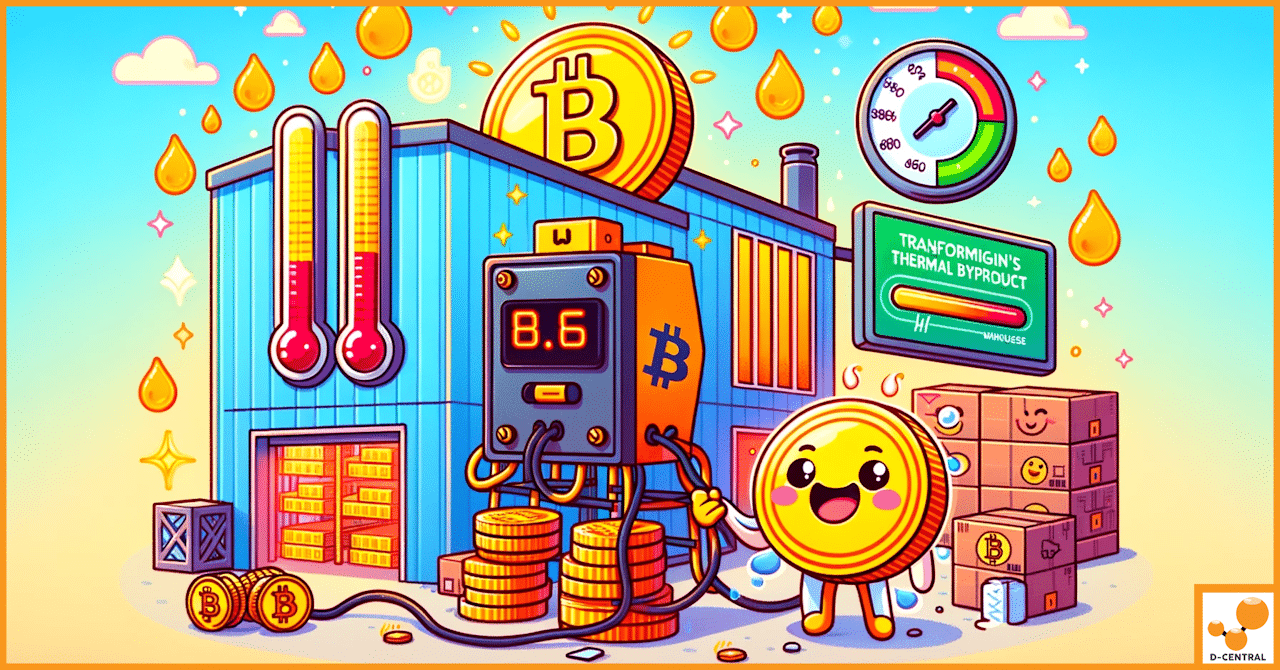
Avoid Cloud Mining Scams: Your Essential Guide
In the ever-evolving world of cryptocurrency, cloud mining has emerged as a beacon of opportunity, attracting investors and enthusiasts alike.
4479 Desserte Nord Autoroute 440, Laval, QC H7P 6E2

Bitcoin mining is a cornerstone of the cryptocurrency ecosystem, fueling the operation and security of Bitcoin, the most recognized digital currency. This process entails miners solving complex cryptographic puzzles to verify transactions and secure the network, maintaining the decentralized ethos at the heart of Bitcoin.
Despite its critical role, Bitcoin mining is associated with substantial energy consumption which leads to significant heat generation. Traditionally, this heat has been viewed as a waste byproduct, requiring extensive cooling solutions that elevate operational costs and complicate facility management. This heat, if not managed properly, not only represents lost potential energy but also adds environmental and economic burdens to mining operations.
Recognizing the challenges posed by this excessive heat generation, innovative solutions are now being sought to harness this thermal byproduct as a valuable resource. There is a growing opportunity to transform this otherwise wasted energy into a beneficial asset, reducing overhead costs for miners and potentially providing heat for other practical applications such as building heating or industrial processes. This article explores the potential for repurposing Bitcoin’s thermal byproduct, envisioning a scenario where both miners and warehouses benefit, thereby enhancing the sustainability and efficiency of mining operations while contributing positively to the broader community.
Bitcoin mining is the backbone of the Bitcoin network, providing security and confirming transactions across the blockchain. This process involves miners using specialized hardware known as ASICs (Application-Specific Integrated Circuits) to solve complex mathematical puzzles. Each solution finds a new block, which is added to the blockchain, and the miner is rewarded with bitcoins. This computationally intensive task requires significant electrical power, which is converted into processing power and, unavoidably, a large amount of heat as a byproduct.
Details on the Amount of Heat Generated and Traditional Methods Used for Cooling
The intense processing power required for Bitcoin mining results in high heat output from mining hardware. For instance, popular mining rigs operate at considerable power ratings, often exceeding 1000 watts, akin to the power usage of a medium household appliance but running continuously 24/7. Traditionally, miners have used various cooling methods to manage this heat, including air conditioning, custom-built ventilation systems, and even immersion cooling, where hardware is submerged in a thermally conductive but electrically insulating fluid. These methods help prevent hardware from overheating, ensuring efficiency and longevity of the equipment.
Environmental Impact of the Heat Waste and Energy Consumption in Bitcoin Mining
The environmental impact of Bitcoin mining has been a topic of increasing concern. The primary issue revolves around the enormous amount of energy consumed by mining operations, which often rely on non-renewable energy sources. This consumption leads to significant carbon emissions, contributing to global warming. Additionally, the heat produced and often wasted in the environment adds a layer of thermal inefficiency that exacerbates local heat levels, potentially impacting nearby ecosystems and communities.
Efforts are ongoing within the industry to address these challenges by adopting renewable energy sources, improving the efficiency of mining equipment, and exploring innovative ways to repurpose the waste heat in beneficial ways.
Waste heat recovery refers to the process of capturing and reusing heat from various industrial processes that would otherwise be lost to the environment. This heat can originate from numerous sources within industrial settings, including combustion engines, furnaces, or any process that generates excess thermal energy. The practice of recovering waste heat is crucial across various industries, such as manufacturing, power generation, and transportation, because it significantly enhances energy efficiency.
Overview of Current Technologies and Methods Used in Heat Recovery Systems Several technologies are employed to capture and repurpose waste heat, each suited to different industrial applications and heat grades (low, medium, or high):
Benefits of Waste Heat Recovery in Reducing Operational Costs and Environmental Impact The advantages of implementing waste heat recovery systems are twofold:
Incorporating waste heat recovery systems not only fosters more sustainable industrial practices but also aligns with global efforts to enhance energy efficiency and reduce environmental degradation. This approach not only benefits the bottom line but also contributes to broader ecological and economic sustainability goals.
In the realm of Bitcoin mining, several advanced technologies can be employed to repurpose the considerable amount of heat produced during the mining process:
Steps and Strategies for Integrating These Technologies into Existing Mining Operations
Integrating heat recovery systems into existing Bitcoin mining operations involves several key steps:
Potential Challenges and Solutions in Adopting Heat Recovery Systems in the Cryptocurrency Mining Sector
Adopting heat recovery technologies in Bitcoin mining operations presents several challenges, along with potential solutions:
By addressing these challenges with well-thought-out strategies, Bitcoin mining operations can not only enhance their energy efficiency but also turn a cost center into a source of value. This transition not only supports the sustainability of the mining operation but also contributes to broader environmental goals by reducing overall energy consumption and carbon emissions.
Transforming the thermal byproducts of Bitcoin mining into usable energy can significantly enhance the economic efficiency of mining operations. Here are the key ways this transformation can lead to cost savings and increased profitability:
Environmental Benefits of Repurposing Thermal Energy
The environmental impact of repurposing thermal energy from Bitcoin mining operations is equally significant:
By focusing on both economic and environmental benefits, Bitcoin mining operations that invest in heat recovery technologies not only bolster their profitability but also contribute to broader sustainability goals. This dual benefit strengthens the business case for adopting such systems, encouraging more widespread implementation in the cryptocurrency mining industry and beyond.
Throughout this article, we have explored the transformative potential of repurposing thermal byproducts in Bitcoin mining operations. From an in-depth look at the innovative technologies that facilitate heat recovery to detailed case studies showcasing successful implementations across industries, it’s clear that transforming waste heat offers significant economic and environmental benefits.
The importance of leveraging Bitcoin’s thermal byproduct cannot be overstated. As the cryptocurrency mining industry continues to grow, the need for sustainable practices becomes increasingly crucial. By enhancing energy efficiency and reducing environmental impact, the mining sector can align more closely with global sustainability targets.
We urge industry stakeholders, from mining operators to technology developers, to consider innovative solutions for heat recovery. Investing in such technologies not only fosters economic gain and operational efficiency but also contributes to the broader, critical agenda of environmental sustainability.
As we move forward, it is imperative that the cryptocurrency mining community collaborates to promote and implement these green innovations. By doing so, we can ensure that the future of mining is not only profitable but also environmentally responsible, setting a standard for other industries to follow.
What is Bitcoin mining?
Bitcoin mining is the process by which new bitcoins are entered into circulation. It involves solving complex cryptographic puzzles to verify transactions, which are then added to the blockchain, securing the network. Miners use specialized hardware to perform this task, in return for new bitcoins as rewards.
Why does Bitcoin mining generate so much heat?
Bitcoin mining generates a substantial amount of heat due to the intensive computational effort required to solve cryptographic puzzles. The specialized hardware, ASICs (Application-Specific Integrated Circuits), consumes significant electrical power, converting most of it into processing power and heat.
What are the traditional methods used for cooling Bitcoin mining operations?
Traditional cooling methods in Bitcoin mining include air conditioning, custom-built ventilation systems, and immersion cooling. These approaches are designed to dissipate the heat generated by mining hardware, maintaining operational efficiency and equipment longevity.
What is the environmental impact of Bitcoin mining?
The environmental impact of Bitcoin mining revolves around its significant energy consumption and the associated carbon emissions, particularly when non-renewable energy sources are used. Additionally, the heat produced by mining operations, if not managed correctly, can add to local thermal inefficiencies and environmental burdens.
What is waste heat recovery?
Waste heat recovery involves capturing and repurposing heat from industrial processes that would otherwise be lost to the environment. This process improves energy efficiency by using recovered heat for other practical applications, such as heating buildings or industrial processes.
How can heat recovery benefit Bitcoin mining operations?
Heat recovery can significantly benefit Bitcoin mining by reducing cooling costs, generating additional revenue through the production of electricity, and increasing the hardware’s longevity. This not only reduces operational costs but also lessens the environmental footprint by improving energy efficiency and reducing greenhouse gas emissions.
What challenges might Bitcoin mining operations face in adopting heat recovery systems?
Challenges include high initial costs, technical complexity, space constraints, and regulatory hurdles. Solutions involve seeking financial incentives, partnering with engineering firms for expertise, opting for compact solutions, and early engagement with regulatory bodies to ensure compliance.
What are the economic and environmental benefits of repurposing thermal energy in Bitcoin mining?
Economically, repurposing thermal energy reduces cooling and operational costs, generates additional income through the sale of generated electricity, and increases mining hardware longevity. Environmentally, it contributes to a reduction in greenhouse gas emissions, promotes sustainable mining practices, and supports the integration of renewable energy sources, enhancing overall energy efficiency.
DISCLAIMER: D-Central Technologies and its associated content, including this blog, do not serve as financial advisors or official investment advisors. The insights and opinions shared here or by any guests featured in our content are provided purely for informational and educational purposes. Such communications should not be interpreted as financial, investment, legal, tax, or any form of specific advice. We are committed to advancing the knowledge and understanding of Bitcoin and its potential impact on society. However, we urge our community to proceed with caution and informed judgment in all related endeavors.
Related Posts

In the ever-evolving world of cryptocurrency, cloud mining has emerged as a beacon of opportunity, attracting investors and enthusiasts alike.

In the rapidly evolving world of cryptocurrency, ASIC (Application-Specific Integrated Circuit) mining stands out as a cornerstone for securing blockchain

In the dynamic world of cryptocurrency, Bitcoin mining stands as a cornerstone activity, essential for the maintenance and growth of